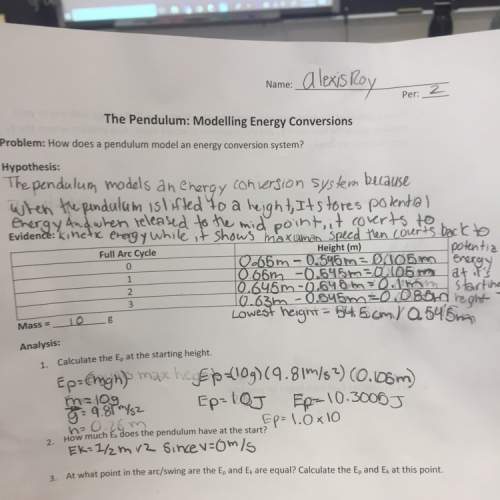
Physics, 08.02.2021 18:50 faithburleson13
At what speed, in m/s, would a moving clock lose 1.3ns in 1.0 day according to experimenters on the ground?

Answers: 2
Another question on Physics

Physics, 22.06.2019 06:30
=force × distance a. work b. velocity c. pressure d. momentum
Answers: 1

Physics, 22.06.2019 14:40
14. a body is projected with velocity vi from a.at the same time another body is projectedvertically upwards from point b withvelocity v2 lies vertically below the highestpoint. both the bodies collide thenv2÷v1is
Answers: 1

Physics, 22.06.2019 16:00
Fill in the blanks with the numbers is a measure of the resistance to flow. a high liquid has a high resistance to flow and flows slowly. the ancients thought everything in the world was made of 4 we now know that there are 94 naturally occurring and scientists have created another 24 i am certain they will create even more. honey flows slowly because it has a high to flowing. a can be separated by physical means because it contains more than one pure substance and 2 pure substances are not chemically bonded to each other. a cannot be separated by physical means. all matter is made up of all elements are with the same number of protons. if it is just a single or many bonded together, if all of them have the same number of protons, it is an element. in a piece of pure iron metal, all the are joined together, that piece of iron metal is called elemental iron. a single of iron is called elemental iron. a mixture has differences from place to place. we might need a microscope to see them or they might be obvious to the unaided eye. there are surfaces separating it into different phases. a mixture is the same everywhere. it is uniform. there are no surfaces separating it into different phases. if different kinds of atoms (different elements) are bonded together by their electrons, it is called a there are physical means of to isolate the different pure substances in a mixture and there are chemical means of to isolate the different elements in a compound. 1. element 2. compound 3. mixture 4. heterogeneous 5. homogeneous 6. pure substance 7. atoms 8. separation 9. viscosity 10. resistance
Answers: 3

Physics, 22.06.2019 19:20
Two kilograms of air within a piston–cylinder assembly executes a carnot power cycle with maximum and minimum temperatures of 800 k and 300 k, respectively. the heat transfer to the air during the isothermal expansion is 60 kj. at the end of the isothermal expansion the volume is 0.4 m3. assume the ideal gas model for the air. determine the thermal efficiency, the volume at the beginning of the isothermal expansion, in m3, and the work during the adiabatic expansion, in kj.
Answers: 1
You know the right answer?
At what speed, in m/s, would a moving clock lose 1.3ns in 1.0 day according to experimenters on the...
Questions

Mathematics, 04.07.2019 19:30

Mathematics, 04.07.2019 19:30

Mathematics, 04.07.2019 19:30






Biology, 04.07.2019 19:30


Geography, 04.07.2019 19:30

Social Studies, 04.07.2019 19:30


Spanish, 04.07.2019 19:30

Spanish, 04.07.2019 19:30


English, 04.07.2019 19:30

Social Studies, 04.07.2019 19:30

History, 04.07.2019 19:30




